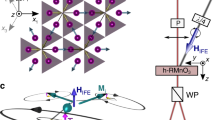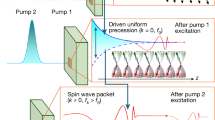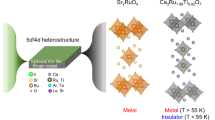Abstract
Magnetic damping is of critical importance for devices that seek to exploit the electronic spin degree of freedom, as damping strongly affects the energy required and speed at which a device can operate. However, theory has struggled to quantitatively predict the damping, even in common ferromagnetic materials1,2,3. This presents a challenge for a broad range of applications in spintronics4 and spin-orbitronics that depend on materials and structures with ultra-low damping5,6. It is believed that achieving ultra-low damping in metallic ferromagnets is limited by the scattering of magnons by the conduction electrons. However, we report on a binary alloy of cobalt and iron that overcomes this obstacle and exhibits a damping parameter approaching 10−4, which is comparable to values reported only for ferrimagnetic insulators7,8. We explain this phenomenon by a unique feature of the band structure in this system: the density of states exhibits a sharp minimum at the Fermi level at the same alloy concentration at which the minimum in the magnetic damping is found. This discovery provides both a significant fundamental understanding of damping mechanisms and a test of the theoretical predictions proposed by Mankovsky and colleagues3.
This is a preview of subscription content, access via your institution
Access options
Subscribe to this journal
Receive 12 print issues and online access
$259.00 per year
only $21.58 per issue
Buy this article
- Purchase on SpringerLink
- Instant access to full article PDF
Prices may be subject to local taxes which are calculated during checkout



Similar content being viewed by others
References
Ebert, H., Mankovsky, S., Ködderitzsch, D. & Kelly, P. J. Ab initio calculation of the Gilbert damping parameter via the linear response formalism. Phys. Rev. Lett. 107, 66603–66607 (2011).
Gilmore, K., Idzerda, Y. U. & Stiles, M. D. Identification of the dominant precession-damping mechanism in Fe, Co, and Ni by first-principles calculations. Phys. Rev. Lett. 99, 027204 (2007).
Mankovsky, S., Ködderitzsch, D., Woltersdorf, G. & Ebert, H. First-principles calculation of the Gilbert damping parameter via the linear response formalism with application to magnetic transition metals and alloys. Phys. Rev. B 87, 014430 (2013).
Žutic, I., Fabian, J. & DasSarma, S. Spintronics: fundamentals and applications. Rev. Mod. Phys. 76, 323–410 (2004).
Emori, S., Bauer, U., Ahn, S.-M., Martinez, E. & Beach, G. S. D. Current-driven dynamics of chiral ferromagnetic domain walls. Nature Mater. 12, 611–616 (2013).
Jué, E. et al. Chiral damping of magnetic domain walls. Nature Mater. 15, 272–277 (2016).
Allivy Kelly, O. et al. Inverse spin Hall effect in nanometer-thick yttrium iron garnet/Pt system. Appl. Phys. Lett. 103, 082408 (2013).
Onbasli, M. C. et al. Pulsed laser deposition of epitaxial yttrium iron garnet films with low Gilbert damping and bulk-like magnetization. APL Mater. 2, 106102 (2014).
Kamberský, V. FMR linewidth and disorder in metals. Czech. J. Phys. B 34, 1111–1124 (1984).
Kamberský, V. On ferromagnetic resonance damping in metals. Czech. J. Phys. B 26, 1366–1383 (1976).
Kambersky, V. & Patton, C. E. Spin-wave relaxation and phenomenological damping in ferromagnetic resonance. Phys. Rev. B 11, 2668–2672 (1975).
Thonig, D. & Henk, J. Gilbert damping tensor within the breathing Fermi surface model: anisotropy and non-locality. New J. Phys. 16, 013032 (2014).
Brataas, A., Tserkovnyak, Y. & Bauer, G. E. W. Scattering theory of Gilbert damping. Phys. Rev. Lett. 101, 037207 (2008).
Liu, Y., Starikov, A. A., Yuan, Z. & Kelly, P. J. First-principles calculations of magnetization relaxation in pure Fe, Co, and Ni with frozen thermal lattice disorder. Phys. Rev. B 84, 014412 (2011).
Oogane, M. et al. Magnetic damping in ferromagnetic thin films. Jpn. J. Appl. Phys. 45, 3889–3891 (2006).
Chang, H. et al. Nanometer-thick yttrium iron garnet films with extremely low damping. IEEE Magn. Lett. 5, 6700204 (2014).
Liu, C., Mewes, C. K. A., Chshiev, M., Mewes, T. & Butler, W. H. Origin of low Gilbert damping in half metals. Appl. Phys. Lett. 95, 022509 (2009).
Mizukami, S. et al. Low damping constant for CO2FeAl Heusler alloy films and its correlation with density of states. J. Appl. Phys. 105, 07D306 (2009).
Dürrenfeld, P. et al. Tunable damping, saturation magnetization, and exchange stiffness of half-Heusler NiMnSb thin films. Phys. Rev. B 92, 214424 (2015).
Schoen, M. A. W., Shaw, J. M., Nembach, H. T., Weiler, M. & Silva, T. J. Radiative damping in waveguide-based ferromagnetic resonance measured via analysis of perpendicular standing spin waves in sputtered permalloy films. Phys. Rev. B 92, 184417 (2015).
Tserkovnyak, Y., Brataas, A. & Bauer, G. E. W. Enhanced Gilbert damping in thin ferromagnetic films. Phys. Rev. Lett. 88, 117601 (2002).
Hurben, M. J. & Patton, C. E. Theory of two magnon scattering microwave relaxation and ferromagnetic resonance linewidth in magnetic thin films. J. Appl. Phys. 83, 4344–4365 (1998).
Sun, Y. et al. Damping in yttrium iron garnet nanoscale films capped by platinum. Phys. Rev. Lett. 111, 106601 (2013).
Zabloudil, J., Hammerling, R., Szunyogh, L. & Weinberger, P. Electron Scattering in Solid Matter (Springer, 2005).
Durham, P. J., Gyorffy, B. L. & Pindor, A. J. On the fundamental equations of the Korringa–Kohn–Rostoker (KKR) version of the coherent potential approximation (CPA). J. Phys. F 10, 661–668 (1980).
Faulkner, J. S. & Stocks, G. M. Calculating properties with the coherent-potential approximation. Phys. Rev. B 21, 3222–3244 (1980).
Stern, E. A. Rigid-band model of alloys. Phys. Rev. 157, 544–551 (1967).
Lounis, S., Santos Dias, M. dos & Schweflinghaus, B. Transverse dynamical magnetic susceptibilities from regular static density functional theory: evaluation of damping and g shifts of spin excitations. Phys. Rev. B 91, 104420 (2015).
Kamberský, V. On the Landau–Lifshitz relaxation in ferromagnetic metals. Can. J. Phys. 48, 2906–2911 (1970).
Turek, I., Kudrnovsky, J. & Drchal, V. Nonlocal torque operators in ab initio theory of the Gilbert damping in random ferromagnetic alloys. Phys. Rev. B 92, 214407 (2015).
Ortiz, C., Eriksson, O. & Klintenberg, M. Data mining and accelerated electronic structure theory as a tool in the search for new functional materials. Comput. Mater. Sci. 44, 1042–1049 (2009).
Nembach, H. T. et al. Perpendicular ferromagnetic resonance measurements of damping and Lande g-factor in sputtered (Co2Mn)1−xGex films. Phys. Rev. B 84, 054424 (2011).
Becke, A. D. Density-functional exchange-energy approximation with correct asymptotic behavior. Phys. Rev. A 38, 3098–3100 (1988).
Langreth, D. C. & Mehl, M. J. Beyond the local-density approximation in calculations of ground-state electronic properties. Phys. Rev. B 28, 1809–1834 (1983).
Perdew, J. P. et al. Erratum: atoms, molecules, solids, and surfaces: applications of the generalized gradient approximation for exchange and correlation. Phys. Rev. B 48, 4978 (1993).
Perdew, J. P. & Wang, Y. Accurate and simple analytic representation of the electron-gas correlation energy. Phys. Rev. B 45, 13244–13249 (1992).
Asada, T. & Terakura, K. Generalized-gradient-approximation study of the magnetic and cohesive properties of bcc, fcc, and hcp Mn. Phys. Rev. B 47, 15992–15995 (1993).
Paxton, A. T., Methfessel, M. & Polatoglou, H. M. Structural energy-volume relations in first-row transition metals. Phys. Rev. B 41, 8127–8138 (1990).
Acknowledgements
O.E. acknowledges support from the Swedish Research Council (VR) and the Knut and Alice Wallenberg Foundation (projects 2013.0020 and 2012.0031). DOS calculations were performed under a SNIC project.
Author information
Authors and Affiliations
Contributions
M.A.W.S. and D.T. wrote the manuscript, J.M.S. and H.T.N. conceived of the experiment, M.A.W.S. deposited the samples, and performed the SQUID measurements and analysis, M.A.W.S., M.L.S. and H.T.N. performed the FMR measurements and analysis, J.M.S. performed the XRD measurements and analysis, D.T. and O.E. performed the first-principles DFT calculations. All authors contributed to the interpretation of the results.
Corresponding author
Ethics declarations
Competing interests
The authors declare no competing financial interests.
Supplementary information
Supplementary information
Supplementary information (PDF 1585 kb)
Rights and permissions
About this article
Cite this article
Schoen, M., Thonig, D., Schneider, M. et al. Ultra-low magnetic damping of a metallic ferromagnet. Nature Phys 12, 839–842 (2016). https://doi.org/10.1038/nphys3770
Received:
Accepted:
Published:
Issue date:
DOI: https://doi.org/10.1038/nphys3770
This article is cited by
-
Reversal of nanomagnets by propagating magnons in ferrimagnetic yttrium iron garnet enabling nonvolatile magnon memory
Nature Communications (2023)
-
Anisotropy of magnetic damping in Ta/CoFeB/MgO heterostructures
Scientific Reports (2023)
-
Role of Y3+ on the temperature-dependent magnetic properties of Lu orthoferrite prepared by solution combustion method using a mixture of fuels
Journal of Materials Science: Materials in Electronics (2023)
-
Anisotropic long-range spin transport in canted antiferromagnetic orthoferrite YFeO3
Nature Communications (2022)
-
Dynamical behaviour of ultrathin [CoFeB (tCoFeB)/Pd] films with perpendicular magnetic anisotropy
Scientific Reports (2021)



